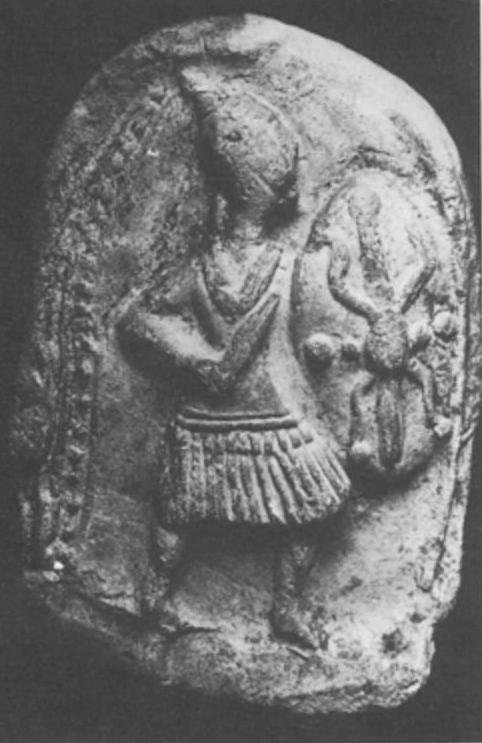Bactrian Greek Terracotta Plaque of a Warrior, Kampyr-tepe
 Image Source: “New Terracottas from North Bactria” by Galina A. Pugačenkova, pp. 49-67 East and West Vol. 42, No. 1 (March 1992) |
 Image Source: “New Terracottas from North Bactria” by Galina A. Pugačenkova, pp. 49-67 East and West Vol. 42, No. 1 (March 1992) |
Kampyr Tepe is situated in the Surkhan Darya region, about 30 km. west of Termez (ancient North-Western Bactria, modern Southern Uzbekistan).
No. 1 (PI. XIVa and Fig. 2) (from Tower 2 of the citadel). On this moulded terracotta plaque is the single figure of a warrior in low relief. He stands under an arch. The body is shown frontally with head and legs in profile turned to the right. He wears a corselet and cuisses in the shape of a skirt; a helmet is on his head and the legs are covered with greaves. He holds the typical Greek short sword of stretched rhombic shape (xiphos) in his right hand and protects himself with a large oval shield. Who is represented here? Pugachenkova, who first published the plaque, thinks that a Roman soldier is being depicted and dates it to the first half of the second century A.D. (Pugachenkova, 1989b; 1989c: 19-21 ). However, this plaque was found in a deposit above which were two layers, and above these in turn was discovered a silver coin of the Graeco-Bactrian king Eucratides (c. 170-145 B.C.) in the plaster of a wall levelled in the Kushan period. Thus, the reign of Eucratides is likely to be the latest period for our terracotta. In addition, items of a warrior's equipment such as the sword-xiphos and the spiked helmet would have been unusual for Roman soldiers. In our opinion, this warrior is equipped with the Hellenistic military outfit: not Roman. This is clear from an analysis of the defensive weapons (see below). This plaque, like other terracottas, served as a small icon, in this case for the worship of a certain local divine (?) hero.
Pugachenkova, G. A., 1989b “Rimskii voin na terrakotovoi plitke iz Kampyrtepa”, Obshchestvennye nauki v Uzbekistane, No. 4, (Tashkent), 55-7.
---, 1989c. “V poiske kul'turriykh tsennostei proshlogo”, Antichnye i rannesrednevekovye drevnosti . . . , 7-28.
Source: “New Data on Ancient Bactrian Body-Armour (in the light of finds from Kampyr Tepe)” by Valeri P. Nikonorov and Serge A. Savchuk (St. Petersburg and Tashkent) in IRAN Volume XXX 1992
Referenced as figure 24a on p.10 in The Armies of Bactria 700BC-450AD Volume 2 (Illustrations) by Valerii P Nikonorov
Figure 24: (a) Terracotta plaque from the citadel of Kampyr-tepe, found in a context dating to the first half of 2nd century BC, which depicts a well-armed warrior standing under an arch (after Nikonorov V P, Savchuk S A, 1992, p.50, Fig 2); see Pl 3A as his reconstruction. G A Pugachenkova (in Obshchestvennye nauki v Uzbekistane 1989, no 4, pp.55-57) has expressed an opinion that this is the image of a Roman soldier on the plaque belonging to the first half of 2nd century AD (?). Her conclusion cannot be accepted, above all because of the above archaeological context of this find. On the other hand, the warrior's outfit assemblage - a spiked helmet, plain cuirass, typical Greek thigh-defence called pteryges which consists of narrow strips made up in two rows (the upper one being much shorter than the lower), large oval shield going back to the thyreos type, and finally distinctive Greek straight sword-xiphos with a short blade of the stretched rhombic form - appears to be of Hellenistic rather than of Roman inspiration.